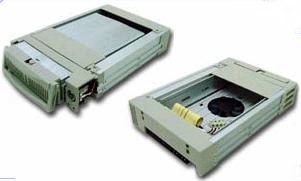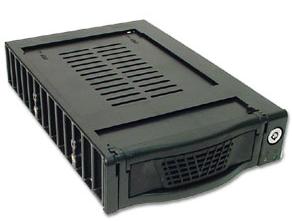
VOICE Home Page: http://www.os2voice.org
[Newsletter Index]
[Previous Page] [Next Page]
[Feature Index]

VOICE Home Page: http://www.os2voice.org |
July 2003
[Newsletter Index]
|
| By Beth Flunker© July 2003 |
Do you want to save yourself some headaches, get away from that awful feeling when your computer hard drive fails to boot up and you have a lot of work to do? If you are not already doing so, you might consider using removable IDE hard drives to keep you up and running.
It happened to me again today, and once again, I am so thankful that I have another hard drive with a working system on it to plug in and do the work that needs to be done right away. I know that many of you already use the removable hard drive that inserts in a bay and gets locked in. But just in case some of you don't, let me tell you how useful this feature can be. By the way, I learned about it from another OS/2 fan, and have been grateful ever since.
The removable hard drive system is simple to install. You receive a bay frame
which fits into a 5.25 inch bay. The frame includes LED lights for power on and
drive activity, and a key slot and key. Some have a fan. You purchase as many drawers
for the frame as you need, and install one 3.5 inch hard drive inside each drawer.
The drawer is inserted into the frame, and locked in, just so you don't remove it
accidentally while you are working, and destroy your file system. Your normal hd
cable is attached to the outside of the frame, and another little cable inside attaches
your hard drive in the drawer. You also insert a couple of screws to stabilize the
hd. The bios recognizes the hard drive as usual, no special drivers are needed.
The cost? Here are some examples:
http://www.xpcgear.com/kinallalhard.html
http://www.compgeeks.com/details.asp?invtid=GN210-BLK
[Editor's note: After reading this article I bought a set of these (the black ones)
but couldn't get it to work until I figured out you have to lock the drive drawer
with the key or there is no power to the drive. Now it works great.] 
http://www.cablemakers.com/mobilerack.htm
Various models
Each manufacturer will include specific instructions for the installation of his product. As you can see by checking the prices on each of the links above, this is not an expensive addition to your computer.
How can you use a removable drive? This is the setup on my computer, which is the main computer in a 3 computer office networked peer-to-peer. All my operating systems reside on the removable drive. I usually install Win98 on one partition, because I need to be able to print out some old files from a Win-only program which refuses to work in Odin. I then install some form of OS2 - which now is always eCS - on another partition. One of my drawers contains a drive which is for experimenting, on which I also install SUSE linux, in addition to win98 and eCS. Any time I want to experiment with new programs or set-ups, I do it on this drive, leaving my main working drive alone, until I am sure I like the results.
I have two fixed drives in my computer besides the removable. One holds all my data, graphics and music files, as well as a partition for programs. The other holds a maintenance installation of eCS and a large partition to which I back up my data files and a copy of my programs partition. (Did I say that I absolutely need my computer to be functioning 7 days a week? Ours is an education environment, in which we have to be able to print out things every day of the week, as well as keep e-mail communication current.)
This morning something happened to make my main eCS partition unbootable. I didn't have much time to deal with it, so, after an alt-F1 and going back to an earlier archived desktop did not solve the problem, I switched off the computer, removed the drive, inserted another drive which also has a working eCS system on it, booted up and did my work for the day. NO SWEAT, NO TEARS! Later I will try to see if the non-working installation can be fixed or if I will have to re-install.
How else could you use a removable drive? I have an extra drive not in use right now, that I plan to install WINXP on, just to test the compatibility of some older programs I want everyone to be able to install and use. After I am satisfied, I can erase the system and use the drive for something else. You could use a drive as your back-up drive, having your operating system installed on a fixed drive. You back up to the removable, and can then take it (in its drawer) away from the premises, if you are concerned about fire or theft. You could put a minimal system on a large removable drive and use the rest of it to back up your data and programs. That way, if your hardware fails, you can insert the drive in another computer and have all your data handy, even boot the system if the computers were similar. (I've done this.) You could install frames on your computer at work and your computer at home and take your data with you. I'm sure you all can think of other ways this inexpensive solution could be used in your computing environment.
As in any situation involving hard drives, you will want to plan master/slave configuration and partition letters according to the usual rules, treating each removable drive as if it were a fixed drive and configuring accordingly. Most of the BIOSes available these days will automatically see and configure the hard drive that you have inserted, provided you have your BIOS set to automatic seek and configure. I have never had a problem with hard drive recognition, and my BIOS is several years old.
One of the reasons that removable drives work so well in eCS and OS2 is that the majority of our programs keep their ini files in the same directory as the program. I can insert a different installation of the operating system on my computer and use the programs that are already installed on a fixed drive without any further fuss. Only Lotus Smartsuite and the Safefire dialer that I use need to be reinstalled on each system. Even with Impos/2, which needs scanner drivers, the drivers can be installed without re-installing the program. PMMail, Mozilla, Staroffice, Injoy dialer, PMView, DeScribe, Impos/2 - the programs I use most - all can be used without further ado with any of the removable hard drives. A few programs will ask you to fill in the registering info again, such as Alarmclock, but I always keep that info handy. I make a point of always giving the operating system partition the same drive letter and same user name, ( so easy to do with LVM) so the network connections work no matter which drive I have inserted.
Have I convinced you? I hope at least a few more people will benefit from this simple addition to a desktop computer and save some stress.
[Feature Index]
editor@os2voice.org
[Previous Page] [Newsletter Index] [Next Page]
VOICE Home Page: http://www.os2voice.org